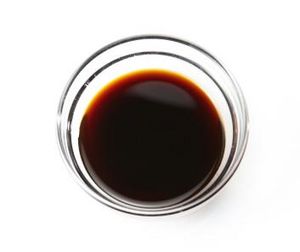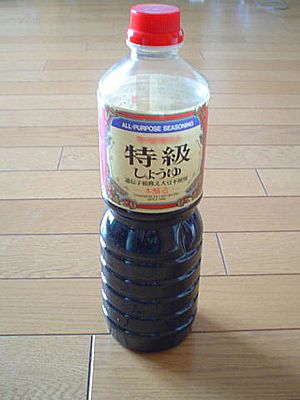Soy sauce facts for kids
Quick facts for kids Soy sauce |
|||||||||||||||
|---|---|---|---|---|---|---|---|---|---|---|---|---|---|---|---|

A bowl of soy sauce
|
|||||||||||||||
| Mandarin Chinese name | |||||||||||||||
| Traditional Chinese | 醬油 | ||||||||||||||
| Simplified Chinese | 酱油 | ||||||||||||||
| Literal meaning | "sauce oil" | ||||||||||||||
|
|||||||||||||||
| Cantonese/Hokkien name | |||||||||||||||
| Chinese | 豉油 | ||||||||||||||
| Literal meaning | "fermented bean oil" | ||||||||||||||
|
|||||||||||||||
| Burmese name | |||||||||||||||
| Burmese | ပဲငံပြာရည် | ||||||||||||||
| Vietnamese name | |||||||||||||||
| Vietnamese | xì dầu or nước tương | ||||||||||||||
| Thai name | |||||||||||||||
| Thai | ซีอิ๊ว (RTGS: si-iw) | ||||||||||||||
| Korean name | |||||||||||||||
| Hangul | 간장 | ||||||||||||||
| Literal meaning | "seasoning sauce" | ||||||||||||||
|
|||||||||||||||
| Japanese name | |||||||||||||||
| Kanji | 醤油 | ||||||||||||||
| Kana | しょうゆ | ||||||||||||||
|
|||||||||||||||
| Malay name | |||||||||||||||
| Malay | kicap | ||||||||||||||
| Indonesian name | |||||||||||||||
| Indonesian | kecap | ||||||||||||||
| Filipino name | |||||||||||||||
| Tagalog | toyo | ||||||||||||||
Soy sauce is a popular liquid seasoning. It is made from soybeans, roasted grains (like wheat), water, and salt. This mixture goes through a special process called fermentation. This means tiny living things, like molds and bacteria, help to break down the ingredients. This process gives soy sauce its unique flavor and color.
Soy sauce is a very important part of Chinese, Japanese, and Korean cuisine. You might also find it in some Western dishes. For example, it is an ingredient in Worcestershire sauce.
Most soy sauces have a little bit of alcohol added when they are bottled. This alcohol helps keep the sauce fresh and stops it from going bad. Because of this, it is best to keep soy sauce in the fridge after you open it. Also, try to keep it out of direct sunlight. If an opened bottle is left out, it might start to taste a little bitter.
All types of soy sauce are salty and have an earthy taste. They are brownish liquids used to add flavor to food while cooking or at the table. The Japanese call a special, savory taste in soy sauce "umami". The Chinese call it "xian-wei," which means "fresh taste." It is a deep, satisfying flavor that makes food taste even better.
This seasoning first came from China. But today, it is used in many different cuisines all over Asia. It is especially important for adding flavor in Japanese cuisine. There are many different kinds of soy sauce, each with its own special qualities.
Contents
How Is Soy Sauce Made?
Soy sauce is made using a process that takes time and care. It starts with soybeans and grains, usually wheat. These ingredients are mixed with water and salt.
The Fermentation Process
The key to making soy sauce is fermentation. This happens when special molds, like Aspergillus sojae (also called kōji), are added. These molds help to break down the soybeans and grains. This creates the rich flavors and aromas of soy sauce.
After the molds do their work, the mixture is left to ferment for several months. During this time, other tiny living things, like yeast and bacteria, also join in. They help to develop the complex taste of the sauce.
Different Types of Soy Sauce
There are many kinds of soy sauce, and they can taste quite different. Some are lighter and saltier, while others are darker and sweeter.
- Light Soy Sauce: This is the most common type. It is salty and used for general cooking and dipping.
- Dark Soy Sauce: This type is thicker, darker, and a little sweeter. It is often used to add color to dishes.
- Sweet Soy Sauce (Kecap Manis): Popular in Indonesia, this soy sauce is very thick and sweet. It is almost like a syrup.
- Japanese Soy Sauce (Shoyu): This type is often made with equal parts soybeans and wheat. It has a balanced flavor.
- Korean Soy Sauce (Ganjang): Traditional Korean soy sauce is often made only from soybeans. It has a strong, deep flavor.
Using Soy Sauce in Cooking
Soy sauce is very versatile. This means it can be used in many different ways in the kitchen.
- Dipping Sauce: Many people use soy sauce as a dipping sauce for foods like sushi, dumplings, or spring rolls.
- Marinades: It is great for marinating meats, poultry, or tofu. It adds a savory flavor and helps to tenderize the food.
- Stir-fries: Soy sauce is a key ingredient in many stir-fry dishes. It adds flavor and helps to create a delicious sauce.
- Soups and Stews: A little soy sauce can add depth and richness to soups, stews, and noodle dishes.
- Dressings: You can even use it in salad dressings or sauces for vegetables.
Images for kids
-
Soy sauce is made from soybeans
-
Toyomansi, a typical Filipino dipping sauce composed of soy sauce and calamansi spiced with siling labuyo
-
Left, ABC brand Kecap manis sweet Indonesian soy sauce is nearly as thick as molasses; right, Kecap asin
-
Soft serve usually topped with Thai sweet soy sauce served at Yaowarat, Bangkok, Thailand
See also
 In Spanish: Salsa de soya para niños
In Spanish: Salsa de soya para niños











